16 F. high in the Twin Cities Wednesday.
23 F. average high on January 15.
30 F. high on January 15, 2012.
.2" snow fell yesterday at MSP.
4.9" snow so far in January, 2014.
21.9" snowfall so far this winter season.
27.8" average snowfall for the winter, to date.
10" snow on the ground in the Twin Cities.
Weather Wimps?
Last
Monday was the coldest day across the Lower 48 since 1997. Yes, it was
dangerously cold, and closing school for 2 days was the right call. It
was the 55th coldest day, nationwide, since 1900.
The irony?
Arctic invasions are becoming more rare in a warming world. When we do
get a taste of the polar vortex it feels like the End Of The World &
climate skeptics spring into full-attack mode.
According to Greg
Carbin at NOAA there have been 58 days since 1900 with U.S. average
temperatures colder than 18F - 27 distinct cold snaps. There were 12
from 1970-1989, only 2 in the 1990s, then last Monday's swipe.
Perspective: since 2000 two days across the USA in the "Top 100 Coldest"
list, and 13 days in the "Top 100 Warmest".
It's
counter-intuitive, but you can get a blizzard with blue sky overhead.
Today's clipper will whip up 30-40 mph wind gusts; blowing snow creating
white-out conditions in open areas, especially western Minnesota, where
a Blizzard Warning is posted. Winds ease on Friday, a glancing blow of
Saturday snow giving way to a Sunday thaw.
Enjoy 30s early next week; models show a series of cold fronts into early February, but not as freakishly cold as last week.
* photo above:
Bryan Hansel Photography.
White-Out Conditions Likely.
Blizzard Warnings have been expanded across western and southwestern
Minnesota for high winds (25-45 mph) capable of whipping up snow already
on the ground. Travel will become increasingly difficult the farther
west you travel on I-94, 12 and 7, away from the Twin Cities. Details
from the local Twin Cities National Weather Service:
...BLIZZARD CONDITIONS DEVELOPING ACROSS WEST CENTRAL AND SOUTH
CENTRAL MINNESOTA THURSDAY...
A BLIZZARD WARNING IS IN EFFECT FOR THURSDAY AND THURSDAY NIGHT
IN WEST CENTRAL AND SOUTH CENTRAL MINNESOTA WHERE CONFIDENCE IS
HIGH THAT WINDS OF 35 TO 40 MPH WITH GUSTS IN EXCESS OF 50 MPH
WILL CAUSE SIGNIFICANT BLOWING AND DRIFTING SNOW AND WHITEOUT
CONDITIONS. THE BLIZZARD WARNING IS GENERALLY WEST OF A LINE FROM
ALEXANDRIA...TO PAYNESVILLE...TO HUTCHINSON AND OWATONNA.
MEANWHILE A WINTER WEATHER ADVISORY REMAINS IN EFFECT FOR CENTRAL
AND EAST CENTRAL MINNESOTA DUE TO REDUCED VISIBILITIES FROM
BLOWING SNOW.
A POWERFUL ARCTIC COLD FRONT WILL MOVE SOUTHEAST ACROSS THE
MINNESOTA THURSDAY MORNING. INCREASING NORTHWEST WINDS OF 20 TO
40 MPH...WITH GUSTS IN EXCESS OF 50 MPH WILL CAUSE SIGNIFICANT
BLOWING AND DRIFTING SNOW. ADDITIONAL LIGHT SNOW WILL OCCUR ALONG
THIS ARCTIC FRONT...WHICH WILL ENHANCE THE BLIZZARD CONDITIONS IN
WEST CENTRAL AND SOUTH CENTRAL MINNESOTA DURING THE DAY AND
EVENING.
ALTHOUGH THE SNOW PACK ACROSS FAR SOUTHERN MINNESOTA ALONG THE
IOWA BORDER IS SHALLOW AND MOSTLY A THIN LAYER OF ICE...THE STRONG
WINDS OF 40 MPH...COUPLED WITH OCCASIONAL LIGHT SNOW...WILL
CREATE WHITEOUT CONDITIONS IN OPEN COUNTRY.
LASTLY...TEMPERATURES WILL RAPIDLY FALL BELOW ZERO...WITH WIND
CHILL READINGS APPROACHING 30 BELOW ZERO BY THURSDAY EVENING.
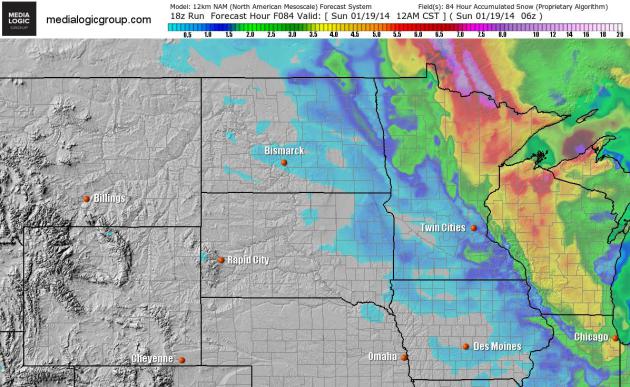
A Series Of Clippings.
NOAA's 12km NAM model shows some 3-4" snowfall amounts over the next 84
hours from the Minnesota Arrowhead into much of Wisconsin; the bulk of
Saturday's snow expected to stay just north/east of the Twin Cities.
Source: Ham Weather.
Super-Sized Alberta Clipper.
Saturday's clipper may drop a plowable snowfall as far south as
Indianapolis and Cincinnati. As long as winds aloft blow from the
northwest it'll be tough for any storms to tap moisture from the Gulf of
Mexico. Map above: NOAA's 84 hour NAM snowfall accumulation.
Cold, But Not January 6 Cold.
I still believe that what we experienced early last week was the worst
of winter (the coldest cold front in 17 years, to be exact). There's a
103% probability of more cold frontal passages in the coming weeks
(that's going out on a limb), but most of them will be a pale imitation
of what we endured last week. 2-meter temperature prediction courtesy of
NOAA and Ham Weather.
Wild Extremes. The map above, courtesy of
Alerts Broadcaster,
shows the warmest and coldest temperatures expected, worldwide, over
the next 72 hours. 100-degree heat for central Argentina and Africa, and
Australia continues to swelter with a growing risk of wildfires.
Putting Last Week's Polar Plunge Into Perspective.
The atmosphere is warming, and the data (NOAA/NASA) shows fewer arctic
outbreaks since the 1990's. But that doesn't mean we won't get whacked
every once in a while. Today's
Climate Matters focuses on the frequency of numbing cold fronts over time: "
WeatherNationTV
Chief Meteorologist Paul Douglas goes over the cold snap that affected
much of the US in the first half of January. But what about the other
half of the nation? California had near record highs and the driest year
on record. The first half of January was well below average for much of
the US, and like flipping a switch, it trends warmer than average.
Weather whiplash anyone?"
2013: 41st Warmest Year On Record For Twin Cities. The 5 warmest years at MSP since 1939: 2012, 1987, 2006, 1998 and 2010, in that order. Source:
NOAA.
2013 USA Weather Recap. Here's a clip from a good overview of weather last year across America, courtesy of
NOAA: "
In 2013, the contiguous United States (CONUS) average temperature of 52.4°F was 0.3°F above the 20th century average, and tied with 1980 as the 37th
warmest year in the 119-year period of record. The 2013 annual
temperature marked the coolest year for the nation since 2009. The 2013
CONUS average temperature was 2.9°F cooler than the 2012 average
temperature, which was the warmest year on record for the nation. Since
1895, when national temperature records began, the CONUS has observed a long-term temperature increase of about 0.13°F per decade. Precipitation averaged across the CONUS in 2013 was 31.17 inches, 2.03 inches above the 20th century average. This marked the 21st wettest year on record for the nation and the wettest since 2009. Compared to 2012, which was the 18th driest year on record, the CONUS was 4.50 inches wetter in 2013. Over the 119-year period of record, precipitation across the CONUS increased at an average rate of 0.17 inch per decade..."
Year's First National Water Forecast Predicts Limited Supply West Of Continental Divide. At
the rate we're going, with unusually dry, mild weather (and brushfires)
during the alleged wet season on the west coast, 2014 may bring record
drought. Here's an excerpt of a press release from the
USDA: "
A
limited water supply is predicted west of the Continental Divide,
according to the USDA Natural Resources Conservation Service (NRCS)
National Water and Climate Center (NWCC) data in its first forecast of
2014. The NWCC also predicts normal water supply east of the Continental
Divide and will continue to monitor, forecast and update water supplies
for the next six months. Monitoring snowpack of 13 western states, the
center's mission is to help the West prepare for spring and summer
snowmelt and streamflow by providing periodic forecasts. It's a tool for
farmers, ranchers, water managers, communities and recreational users
to make informed, science-based decisions about future water
availability..."
Far West Got Drier Last Year, Data Shows. Following up on the story above here's an excerpt from a
New York Times story: "
Drought
conditions in California and elsewhere in the Far West intensified last
year, government scientists said Wednesday, adding to concerns about
water supplies in the region. Although on the whole 2013 was a wetter
than average year for the contiguous 48 states, the scientists said,
that statistic masked sharp regional differences. Many states east of
the Rockies had much higher than average precipitation, helping to
alleviate drought in the central United States and the Southeast..."
* latest U.S. Drought Monitor is
here.
California Drought: What's Causing It?
2013 was the driest year in recorded California history, and a
persistent ridge of high pressure continues to deflect wet, Pacific
storms well north, prompting worries of an even more serious drought in
2014. Here's a clip of a good explanation from the
San Jose Mercury News: "...
With each passing week, California's lack of rainfall becomes more serious. Last
year was the driest calendar year in recorded history in California in
most cities, with records going back 160 years. The first snowpack
reading in the Sierra Nevada earlier this month found a snowpack of just
20 percent of normal..."
Weather graphic above: WeatherWest.com.
Single Digit Danger: Why Cold Weather Raises Heart Risks. Here's an excerpt of a timely and interesting article at
Consumer Affairs: "...
When
temperatures plunge your chance of having a heart attack goes up if you
already have a higher risk of heart trouble. Here's why: cold
temperatures can constrict arteries and raise blood pressure, causing
the heart to work harder or triggering tears or clots in the arteries.
Compared to the summer months, people are 26% to 36% more likely to die
in winter heart-related health issues, according to research cited by
AARP..."
Almost No Americans Die From Lightning Strikes Anymore - Why?
Great question - and the trends are real. Heightened awareness,
education, a migration from farms to cities, new technologies (Doppler
on your cell phone?) along with media updates have dropped the lightning
death rate dramatically. Here's an excerpt of a great recap from
The Atlantic: "
In
the first half of the 20th century, hundreds of Americans died each
year from lightning strikes. The data is messy, but in the years from
about 1920 to the middle of the 1940s, about 400 people were killed by
lightning annually. Last year, 23 did, the fewest on record. Other recent years have had a similarly small number of lightning fatalities, with 28 in 2012, and 26 in 2011,
the previous record. These numbers are all the more remarkable
considering how the population of the United States has exploded over
the same time period.."
Photo credit above: "
Lightning strikes an open field in Clearwater, Kansas." (Reuters).
Surge In Shark Attacks Causes Alarm In Hawaii.
The water is lovely, just keep an eye out for occasional fins. I'll
still take Minnesota's lakes, mosquitoes and all. Here's a clip from
The Los Angeles Times: "...
So
far, the increases in attacks in 2012 and 2013 — which followed three
years in which there were just three shark attacks annually — do not
appear to have affected tourism. More than 2.1 million people visited
Maui last year, figures that Terryl Vencl, executive director of the
Maui Visitors Bureau, said she had not seen since before the recession.
"I think people realize it is still a rare occurrence," Vencl said in an
email. There is no question, however, that many swimmers and snorkelers
are adjusting their routines based on the location of encounters..."
How Safe Is U.S. Drinking Water?
In light of the widespread water contamination impacting residents of
West Virginia, it's probably a timely question to ask. Here's an excerpt
of a story at
Discovery News: "...
Each
year there are more than 10,000 spills of oil and hazardous substances,
according to federal estimates, many that get into water supplies. From
raw sewage to rocket fuel, sometimes these spills evaporate or
dissipate into the air or water. Other times, as in Charleston, W.Va.,
the results are disastrous to human health and wildlife. The nation’s
worst municipal water contamination occurred in Milwaukee in 1993, when
an outbreak of the Cryptosporidium parasite sickened 400,000 people and
killed 69. A malfunctioning filter at the city water plant allowed the
organism to spread throughout the city’s entire public water system..."
Scientists: Americans Are Becoming Weather Wimps.
The reality: we're seeing fewer of the polar invasions that swept
across the USA last week, especially since 2000. So now when it does get
brutally cold for a few days it seems like the end of the world. Back
in the 70s? Business as usual. Here's a clip from
Yahoo News: "...
In
the past 115 years, there have been 58 days when the national average
temperature dropped below 18. Carbin said those occurrences often happen
in periods that last several days so it makes more sense to talk about
cold outbreaks instead of cold days. There have been 27 distinct cold
snaps. Between 1970 and 1989, a dozen such events occurred, but there
were only two in the 1990s and then none until Monday. "These types of
events have actually become more infrequent than they were in the past,"
said Carbin, who works at the Storm Prediction Center in Norman, Okla.
"This is why there was such a big buzz because people have such short
memories..."

Weather Terminology 101.
Here's a clip from an interesting article focused on weather and
climate terms you may be hearing in the popular media these days,
courtesy of
onearth.org: "
The “polar vortex” that froze North America in its tracks this week
isn’t exactly new. Cyclones of frigid air swirl around the Arctic all
the time. What’s different is that this latest polar vortex dipped far
enough south to send Floridians scrambling for their mittens. The term
also showed up all over my Facebook feed. Granted, I run with a lot of
science journalists, but this time even my
let’s-take-a-picture-of-my-breakfast friends (no offense, guys) were
discussing the rare and strange interaction of the polar vortex with the
jet stream and its possible relation to melting Arctic sea ice … driven by climate change. Thanks to wacky weather (and social media hashtags), meteorology geekspeak has hit the mainstream..."
Graphic credit: Mike Fernwood, Flickr.
What Happens When The President Sits Down Next To You At A Cafe. I enjoyed this article from Robinson Meyer at
The Atlantic; here's an excerpt: "...
When
the president arrived, 40 minutes later—stepping out of his SUV,
smiling, with a little wave—the nerves subsided. The cafe is split into
two long halves, and he first turned to visit its opposite half,
smiling, shaking hands, shaking more hands. And then—for the first time
in nearly an hour—I could work. I found that I was so accustomed to his
voice, how he holds his body, his aura, that ignoring him in person is
as easy as ignoring a TV. Easier, in fact. He stops being the president
and starts being That Guy Who You See In Tweets, That Guy Who Gives
Speeches, That Guy..."
Photo credit above: "
The author, at "work". (Pete Souza/The White House)
Golf Bike Provides "Greens" Transportation. Allow me to daydream about 1). summer, 2). golf, and 3). a leisurely bicycle ride. Here's a clip from a story at
Gizmag: "...
So,
what makes the Golf Bike an actual "golf bike"? For starters, it has
built-in golf club bags. Users transfer their clubs into those bags at
the start of a round, making sure to distribute the weight more or less
evenly. It also has small-diameter wheels that require less torque to
accelerate, along with relatively wide, soft tires – both of these
features are intended to minimize damage to the course..."
NameMyDaughter.com.
I know, it's a sad, sorry way to claim your 15 minutes of Internet
fame, but we just can't look away, can we? That poor girl. Here's a clip
from the
web site: "
Hi,
My name is Stephen and much to the disbelief of my wife, I have decided
to let the internet name my daughter. Yeah that is an asterisk,
Unfortunately internet I know better than to trust you. We will
ultimately be making the final decision, Alas my daughter shall not be
named WackyTaco692. Sorry guys the wife wouldn't go for a free for all.
Inappropriate submissions may be removed -- Yeah looking at you Graeme.
You know what you did."
TODAY:
Winter Weather Advisory MSP Metro, Blizzard Warnings western Minnesota.
Gusty winds. White-out for much of central and western MN. NW 30, gusts
to 40. High: 31 (early), falling into the teens
THURSDAY NIGHT: Windy with clearing, turning cold again. Low: near 0
FRIDAY: Partly sunny, better travel, statewide. High: 13
SATURDAY: Another Alberta Clipper; inch or two of snow. Wake-up: 9. High: 25
SUNDAY: Blue sky, hints of late February. Wake-up: 11. High: 39
MONDAY: Mild start, then turning colder. Wake-up: 26. High: 32 (early)
TUESDAY: Some sun, wintry sting returns. Wake-up: -4. High: 8
WEDNESDAY: Next clipper. Light snow possible. Wake-up: -2. High: 10
Climate Stories....
Cool Heads Needed. As
the author points out, it's critical to remember the distinction
between "weather" and "climate" (sort of like comparinig CNN Headline
News to The History Channel). Here's a clip from an article at
Nature News & Comments: "...
Evidence
for the claim that global warming could be disrupting the jet stream is
disputed. Similar weather events have happened in the past, and at
least one review of the record suggests that nothing is amiss — at least
nothing that scientists can pin down as obviously outside the normal
year-to-year seasonal variations. This does not mean that climate change
has no role, of course. It just means that we do not yet know. In the
words of one climate modeller, until the models and the observations
align, we ought to reserve judgement. As far as the public is concerned,
there is little to do but dress appropriately, keep an open mind and
let the science play out..."
Climate Change And The Polar Vortex.
Record warmth over the western USA and much of Europe, while many
Americans are still buzzing about last week's polar invasion, the
coldest since 1997. Here's a clip from a story at
Alaska Dispatch: "...
It
is impossible to say for sure that the weird weather we have been
experiencing is caused by climate change. Climate experts say they need
records of a period of at least 30 years to draw conclusions about
climate trends. The National Oceanic and Atmospheric
Administration confirms, though, that the jet stream has become much
more variable than before over the last five years. Climatologists and
polar experts have been warning for a long time that the rapid warming
of the Arctic could well result in cold periods in other regions. The
decline of the sea ice and snow cover towards the end of autumn are
warming the ocean. The difference between temperatures in the Arctic and
those at mid-latitudes, which help drive the jet stream, is becoming
smaller. Scientists say this could well be responsible for the wavy
patterns of the jet stream which play a key role in determining the
weather..."
Graphic credit above: "
Maps
show the 500-millibar geopotential height (the altitude where the air
pressure is 500 millibars) on January 5, 2014 (left), and in
mid-November 2013 (right). The cold air of the polar vortex is purple." Maps by NOAA Climate.gov, based on NCEP Reanalysis data from NOAA ESRL Physical Sciences Division.
China Doing "Best Job" Tackling Climate Change? They certainly have the biggest problem with smog and pollution in general - here's a clip of a
Bloomberg article that made me do a double-take: "
China,
the top emitter of greenhouse gases, is also the country that’s “doing
it right” when it comes to addressing global warming, the United
Nations’ chief climate official said. The nation has some of the
toughest energy-efficiency standards for buildings and transportation
and its support for photovoltaic technology helped reduce solar-panel costs by 80 percent since 2008, Christiana Figueres, executive secretary of the UN Framework Convention on Climate Change,
said yesterday in an interview at Bloomberg News headquarters in New
York. The country is facing growing public pressure from citizens to
reduce air pollution, due in large part to burning coal. Its efforts to
promote energy efficiency and renewable power stem from the realization
that doing so will pay off in the long term, Figueres said..."
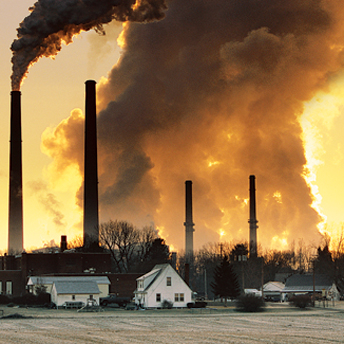 World May Have To Suck Gases From Air To Meet Climate Goals - U.N.
World May Have To Suck Gases From Air To Meet Climate Goals - U.N. It almost sounds like a headline from The Onion, but this one comes from
Reuters; here's an excerpt: "
Governments
may have to extract vast amounts of greenhouse gases from the air by
2100 to achieve a target for limiting global warming, backed by
trillion-dollar shifts towards clean energy, a draft U.N. report showed
on Wednesday. A 29-page summary for policymakers, seen by Reuters, says
most scenarios show that rising world emissions will have to plunge by
40 to 70 percent between 2010 and 2050 to give a good chance of
restricting warming to U.N. targets. The report, outlining solutions to
climate change, is due to be published in Germany
in April after editing by the Intergovernmental Panel on Climate Change
(IPCC). It will be the third in a series by the IPCC, updating science
from 2007..."
Researcher Defends Work Linking Arctic Warming And Extreme Weather.
This is a little technical (from August of 2013), but I thought it
relevant to the article linked above. The data set isn't long enough to
make black and white statements, but there is at least some
circumstantial and anecdotal evidence that rapid warming of far northern
latitudes are impacting the jet stream, especially since the turn of
the century. More research is needed to draw conclusive results, an idea
echoed by meteorologist Jason Samenow in this older post at the
always-interesting
The Capital Weather Gang: "....
On Monday, I wrote about a study
that pushed back against a theory that a warming Arctic and melting ice
are leading to a more volatile jet stream and an increase in extreme
weather in the U.S. and elsewhere. Jennifer Francis, an atmospheric
scientist at Rutgers University and leading proponent of the theory, has
sent me some comments vigorously defending it. Her comments are
technical, but I’ll try to extract the key points (I reproduce the
comments, in their entirety, at bottom of this post)..." Image: NASA.
The Very, Very Thin Wedge Of Denial.
Why don't more climate doubters, skeptics and trolls publish their
works and scientific findings? Here's a clip from a story at
Slate: "...
To
me, one of the most fascinating aspects of climate change denial is how
deniers essentially never publish in legitimate journals, but instead
rely on talk shows, grossly error-laden op-eds, and hugely out-of-date
claims (that were never right to start with). n 2012, National Science
Board member James Lawrence Powell investigated peer-reviewed literature published about climate change and found that out of 13,950 articles, 13,926 supported the reality of global warming. Despite a lot of sound and fury
from the denial machine, deniers have not really been able to come up
with a coherent argument against a consensus. The same is true for a
somewhat different study that showed a
97 percent consensus among climate scientists supporting both the
reality of global warming and the fact that human emissions are behind
it..."
Graphic credit: "
Denial is a thin wedge indeed". Graphic: James Powell.
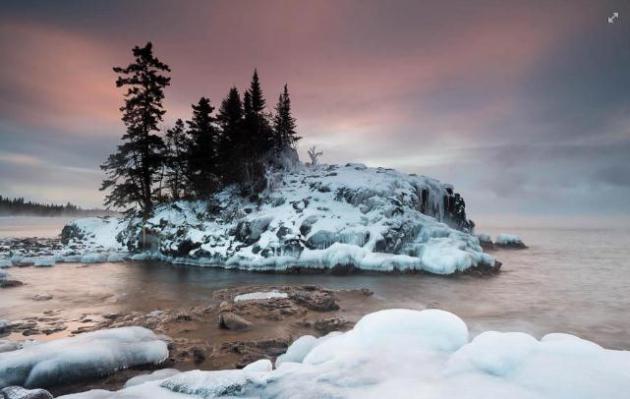



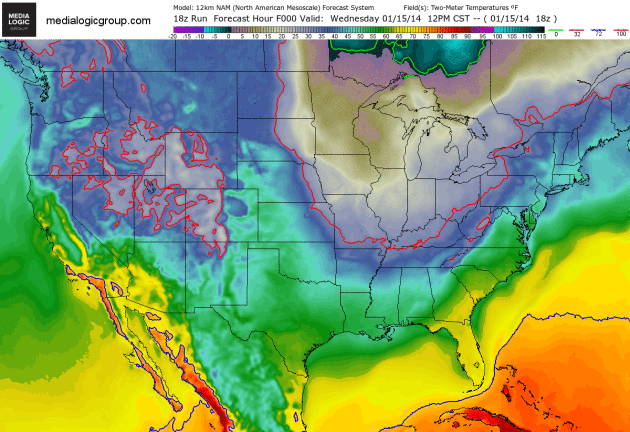

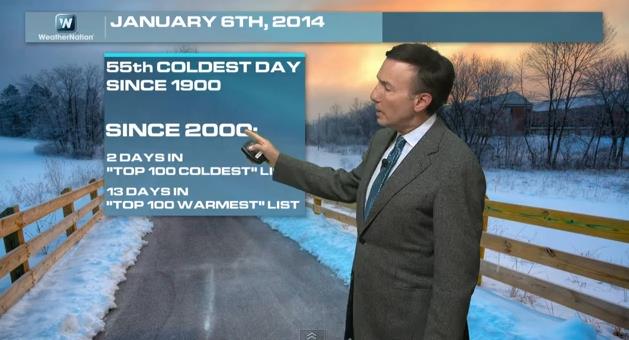

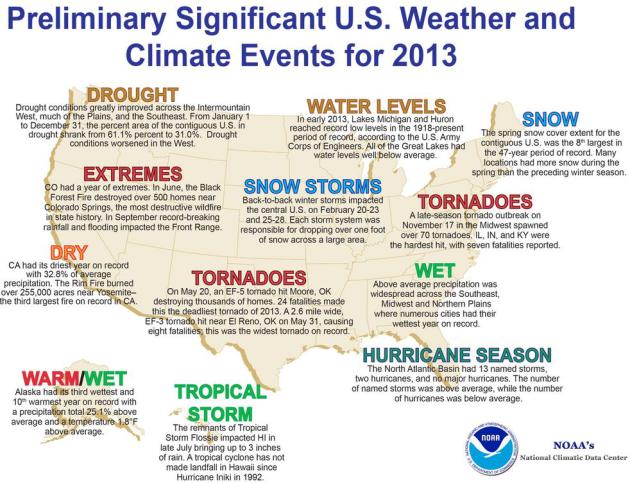

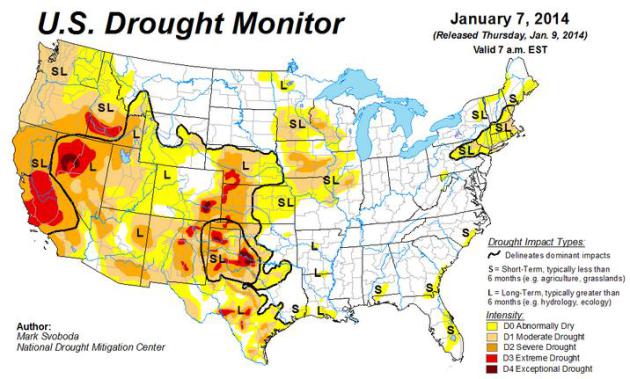
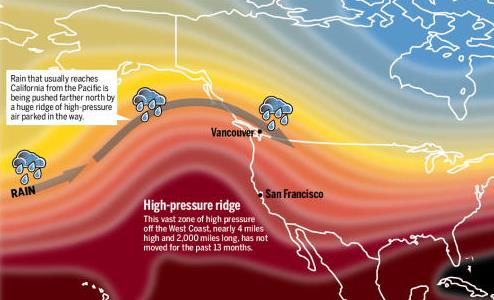

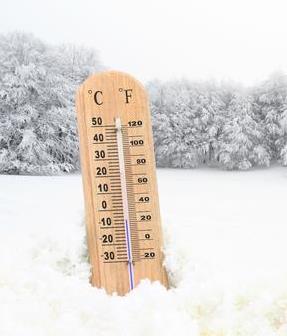
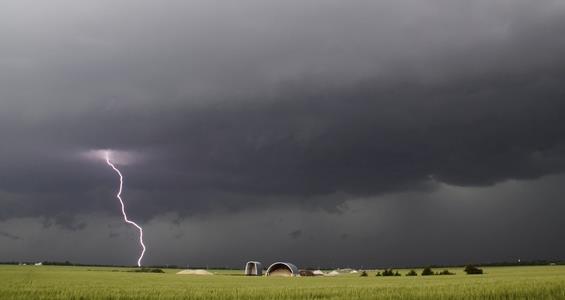


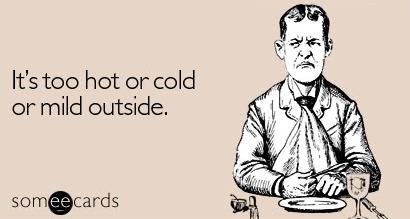


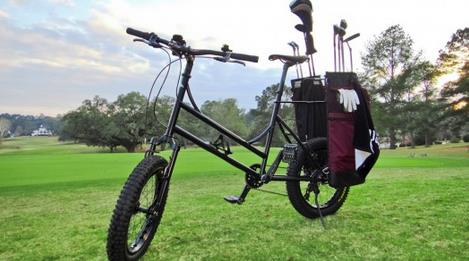


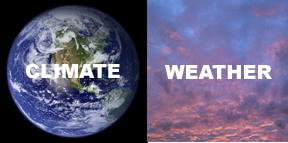

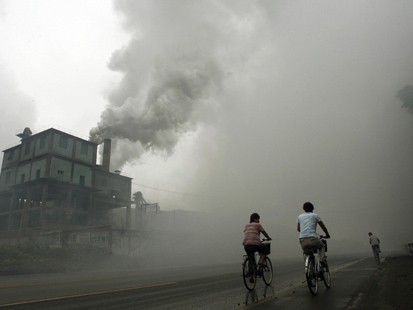


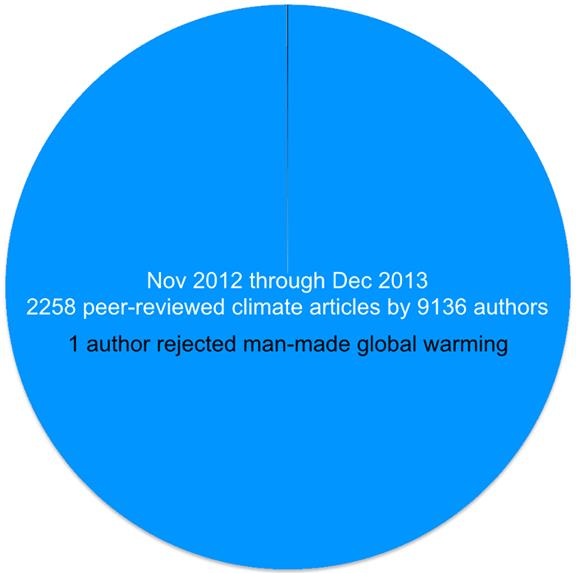
No comments:
Post a Comment